Japanese garden gates serve as more than mere entrances—they represent spiritual transitions between the secular and sacred worlds. These distinctive structures mark the approach to tranquil spaces, creating awareness and setting the tone for the meditative experience ahead. From the iconic vermillion torii gates that grace Shinto temples to the understated elegance of bamboo designs, each style carries profound cultural significance and aesthetic charm. Whether crafted from weathered cedar, woven bamboo, or natural stone, these gates blend traditional Japanese principles with practical functionality. The careful selection of materials, proportions, and symbolic elements transforms a simple passageway into an artistic centerpiece that enhances your garden's overall harmony and invites contemplation.
1. Traditional Vermillion Japanese Garden Gate Torii
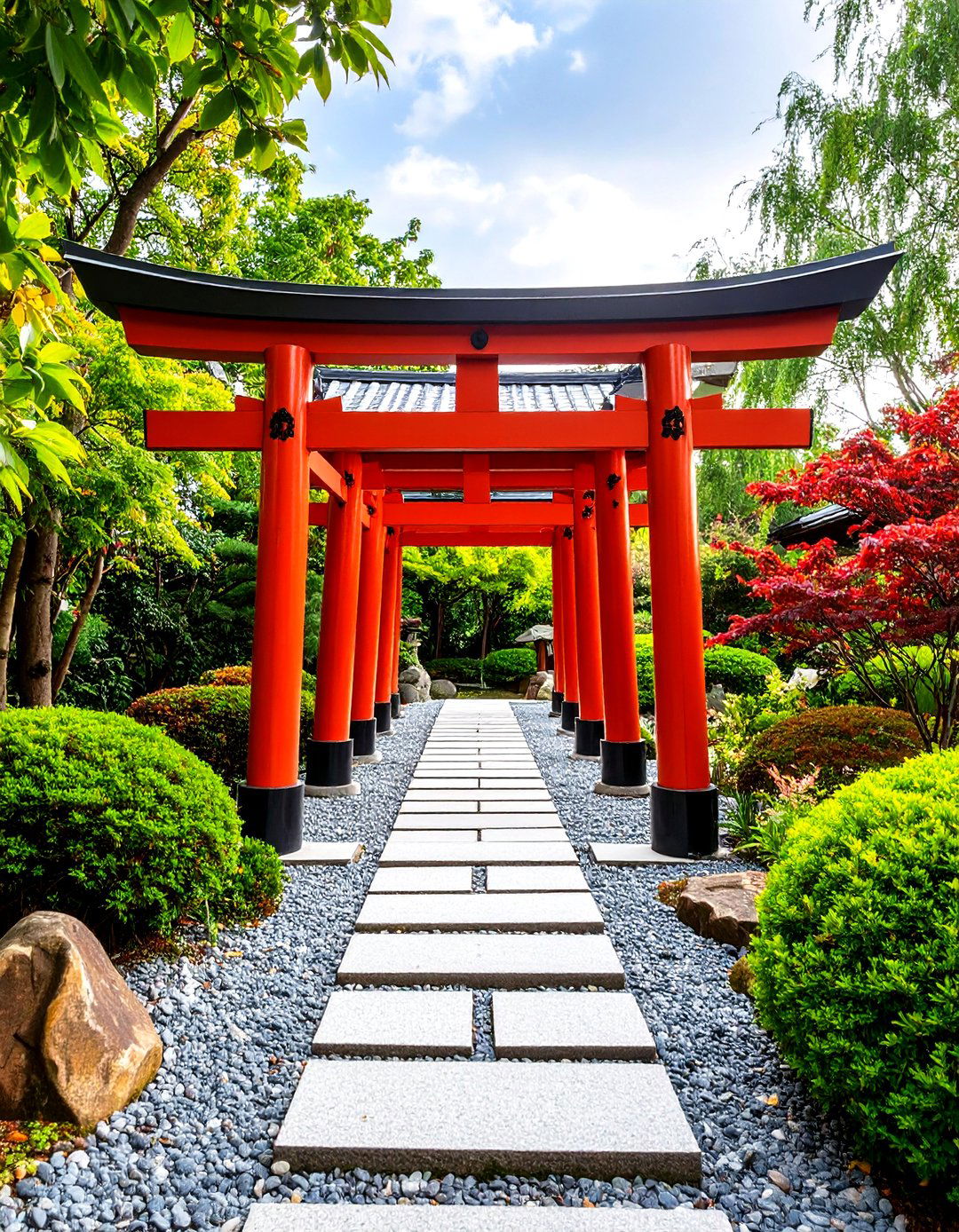
The traditional torii gate represents the most iconic Japanese garden entrance, featuring two vertical posts supporting curved horizontal beams in characteristic vermillion red with black accents. This sacred design marks the transition from the physical to spiritual realm, originally found at Shinto shrine entrances. Constructed with chunky softwood timber profiles, either round or square, these gates typically measure 2.4 meters long by 2.6 meters high. The distinctive curved kasagi (top beam) and straight nuki (secondary beam) create perfect proportions that have remained unchanged for centuries. Traditional finishing includes deep red stain with black "socks" at the post bases, though natural cedar versions develop beautiful silver-grey weathering over time. Installation requires concrete foundations for stability, making this a substantial architectural investment that becomes your garden's defining focal point.
2. Natural Cedar Japanese Garden Gate with Aging Patina
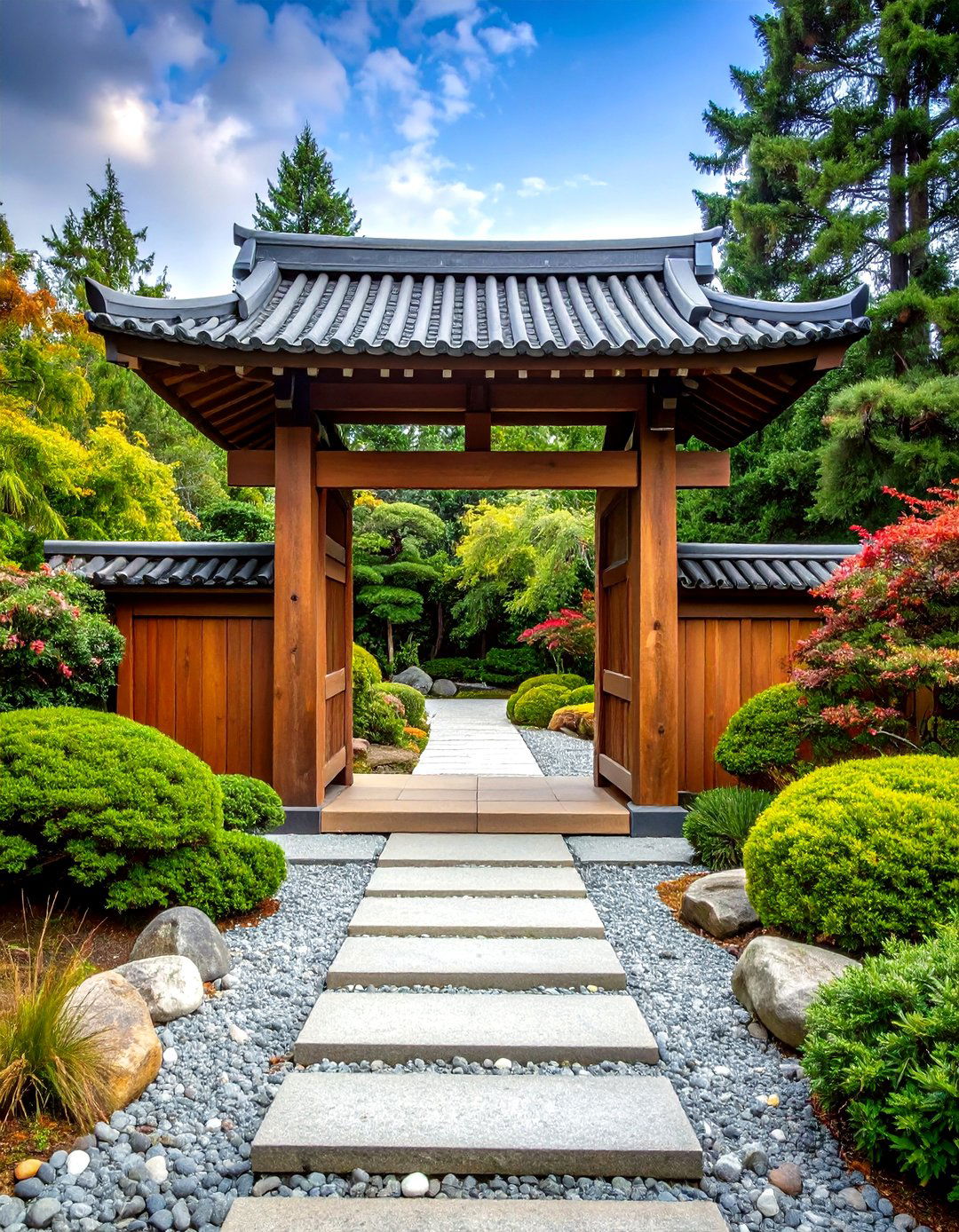
Western Red Cedar Japanese garden gates showcase the beauty of natural materials, developing stunning silver-grey patina as they age gracefully over years. Unlike painted alternatives, these gates embrace the Japanese principle of wabi-sabi, finding beauty in natural imperfection and weathering. The Hōgei Niwamon style features traditional proportions with optional gabled roofs topped with cedar shingles or ceramic kawara tiles. Master craftsmen create these gates using traditional joinery techniques, avoiding modern hardware that might detract from authentic aesthetics. The cedar's natural oils provide inherent weather resistance, requiring minimal maintenance beyond occasional re-oiling. As seasons pass, the wood transforms from warm amber tones to distinguished silver-grey, creating a living testament to time's passage that integrates seamlessly with surrounding landscape elements and enhances the garden's contemplative atmosphere.
3. Bamboo Sleeve Japanese Garden Gate with Stone Lanterns

Bamboo sleeve Japanese garden gates feature vertically secured bamboo poles wrapped with bamboo strips to create visually appealing patterns that exude tranquility and sophistication. This elegant design showcases bamboo's natural flexibility and strength while maintaining traditional Japanese aesthetic principles. Strategic placement of stone lanterns alongside the bamboo sleeve fence creates harmonious garden design that delights the senses and illuminates pathways. The construction method involves careful selection of bamboo poles, ensuring consistent diameter and color matching for optimal visual impact. Bamboo naturally weathers to beautiful grey tones, complementing stone driveways and mountain soil while requiring minimal maintenance. Traditional black twine bindings add authentic detail, while the vertical orientation creates impressive height without overwhelming smaller garden spaces. This sustainable material choice appeals to environmentally conscious gardeners seeking authentic Asian charm.
4. Shoji-Style Sliding Japanese Garden Gate
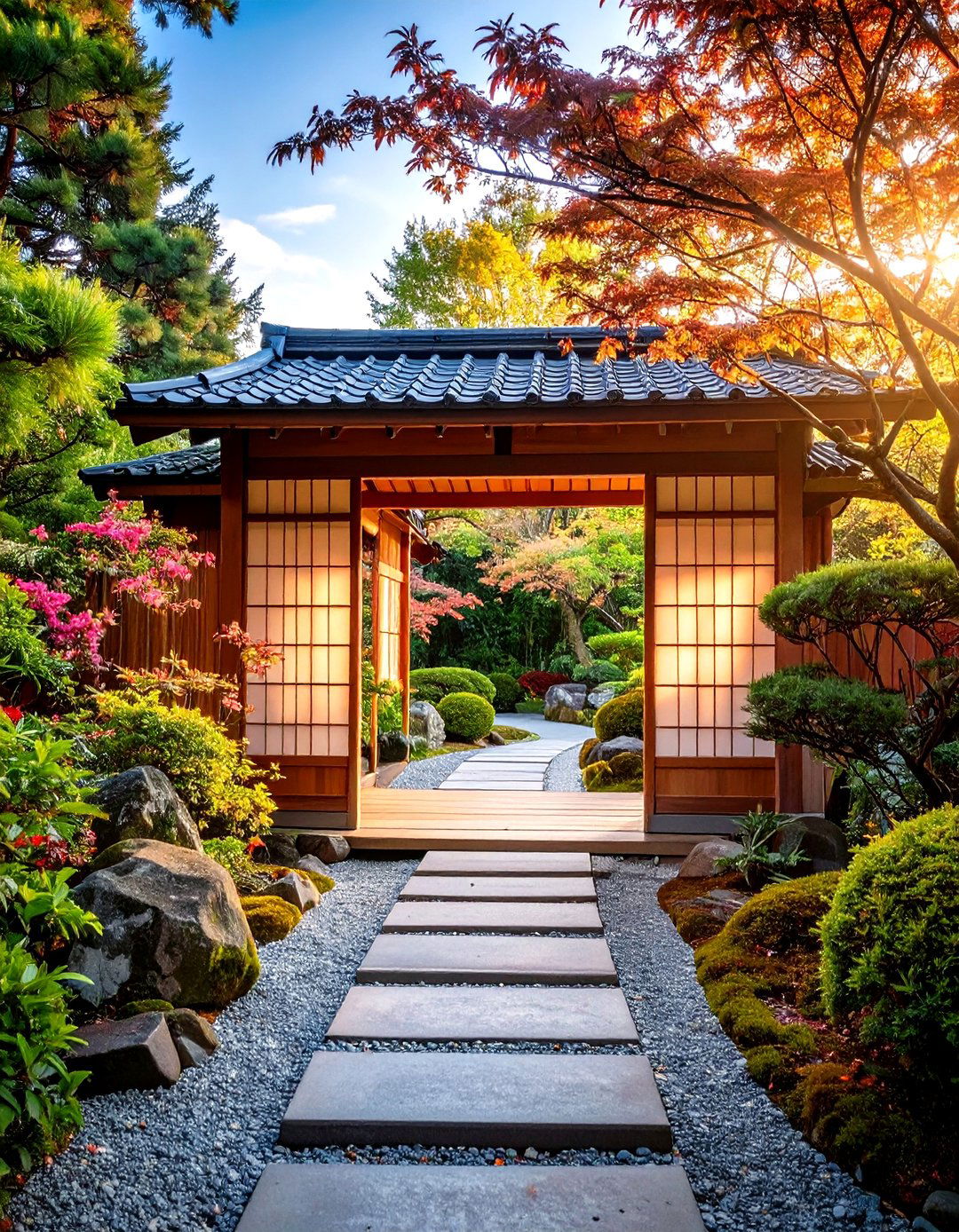
Shoji-style sliding Japanese garden gates feature wooden frames with translucent paper or frosted glass panels, inspired by traditional Japanese sliding doors for space-saving functionality. The sliding mechanism eliminates swing radius requirements, perfect for narrow pathways or confined spaces where traditional hinged gates prove impractical. Soft light filtering through translucent panels enhances the garden's tranquil atmosphere while maintaining privacy and visual intrigue. Construction typically utilizes fine-grained cedar or cypress, with precise joinery creating perfectly square frames that accommodate delicate panel materials. Modern interpretations may incorporate frosted glass for durability, creating layered, misty appearances that work exceptionally well during rainy conditions. The horizontal track system requires proper drainage and regular maintenance to ensure smooth operation. This design particularly suits contemporary interpretations of traditional Japanese gardens, bridging ancient aesthetics with modern functionality requirements.
5. Lattice Pattern Japanese Garden Gate
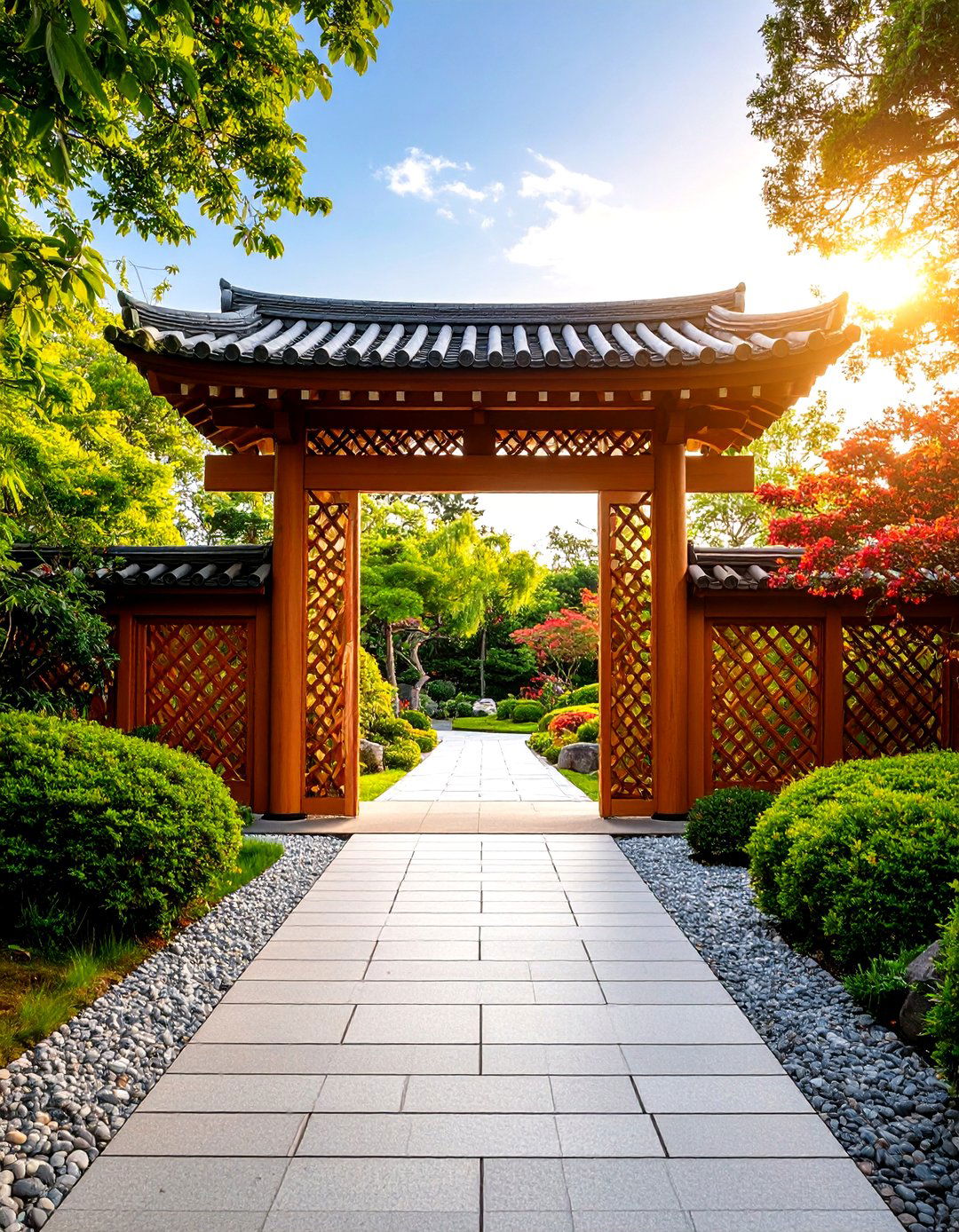
Lattice-style Japanese garden gates bring elegance and openness through crisscross patterns that allow glimpses of the garden beyond, inviting curiosity and exploration. The geometric precision of interwoven wooden or bamboo strips creates visual rhythm while maintaining structural integrity. Traditional Japanese gridwork at the gate's upper section showcases master craftsman skills through perfectly fitted interlocking notches cut using specialized tablesaw jigs. This lightweight design facilitates easy installation while pairing beautifully with climbing plants like ivy or jasmine that soften geometric lines. The lattice pattern provides security without creating fortress-like barriers, maintaining Japanese principles of harmony between built and natural environments. Natural cedar construction allows the gate to weather gracefully, while the open design permits air circulation that prevents moisture buildup. This style particularly suits gardens emphasizing light, airiness, and connection with surrounding landscape elements.
6. Moon Gate Japanese Garden Gate Portal

Moon gate Japanese garden gates feature circular stone or bamboo structures offering perfect portals to garden spaces beyond, inspired by traditional Chinese gardens but adapted for Japanese aesthetics. These gates frame views so perfectly they become integral parts of the scenery themselves, adding elements of mystery and elegance to garden entrances. The circular opening creates dramatic vignettes, drawing attention toward specific focal points like specimen trees, fountains, or hidden benches. Positioning requires careful consideration to maximize visual impact and create stunning photographic opportunities throughout changing seasons. Construction materials range from stacked stone for permanent installations to bamboo frames for lighter, more temporary structures. The circular symbolism represents wholeness, eternity, and cosmic harmony—concepts deeply rooted in Eastern philosophy. Installation considerations include proper foundation work for stone versions and weather protection for bamboo alternatives to ensure longevity.
7. Wabi-Sabi Weathered Japanese Garden Gate
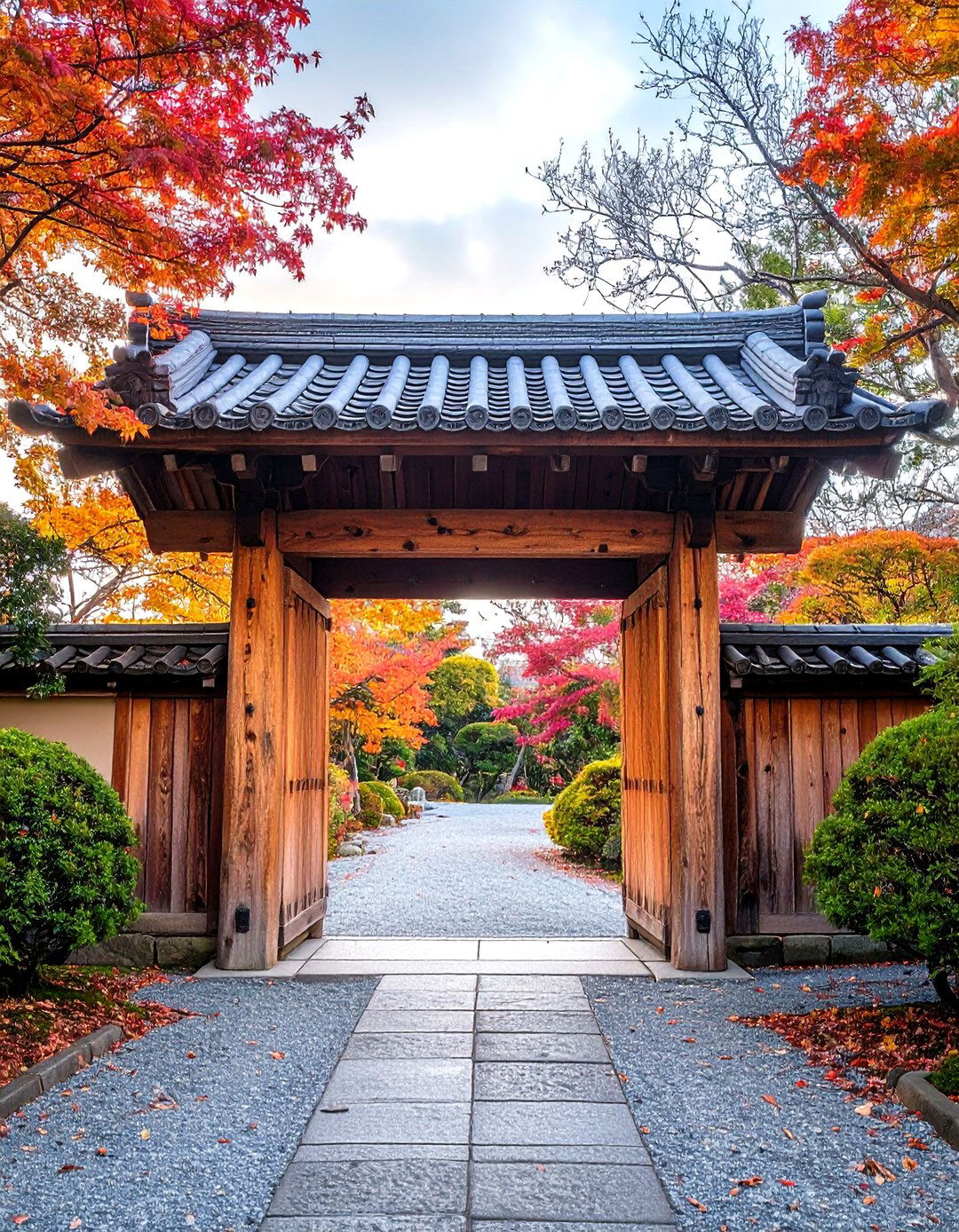
Wabi-sabi inspired weathered Japanese garden gates embrace imperfection to highlight the beauty of natural aging, celebrating rustic textures and subtle asymmetry. This philosophy finds profound beauty in impermanence, imperfection, and incompleteness—core principles of Japanese aesthetics. Weathered surfaces and organic patina create authentic, lived-in appearances that resonate with those appreciating understated elegance. Rustic driftwood gates showcase irregular shapes and textures creating unique, one-of-a-kind designs that complement wabi-sabi philosophy while providing eco-friendly repurposed materials. The aging process becomes part of the gate's beauty, with splits, checking, and color changes telling stories of seasonal cycles. Natural weathering eliminates need for artificial finishes, allowing wood to develop silver-grey patina over time. This approach particularly appeals to gardeners seeking authentic connection with natural processes while creating contemplative spaces that evolve continuously.
8. Stone Pathway Japanese Garden Gate
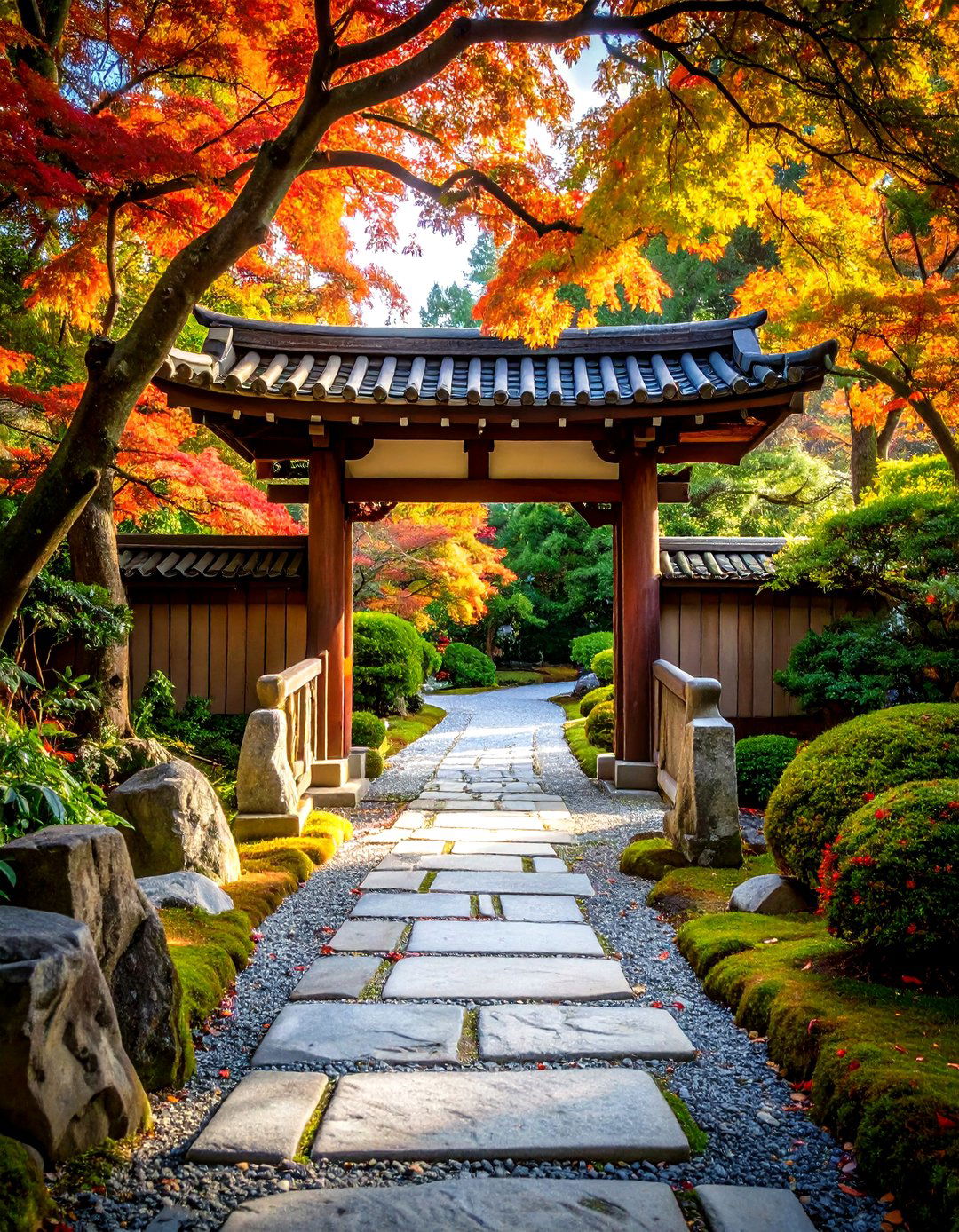
Stone pathway Japanese garden gates create sturdy yet elegant passages carved from natural stone, exuding permanence and artistry through textured surfaces and subtle natural hues. These substantial structures provide lasting beauty that withstands harsh weather conditions while requiring minimal maintenance over decades. Natural stone blends seamlessly with surrounding flora, inviting visitors to step into worlds of timeless beauty. Construction options include stacked fieldstone for rustic appearances or cut granite for formal presentations, each offering distinct aesthetic qualities. Stone elements such as stepping stones or decorative accents add structure and texture to fence designs while creating harmonious blends with natural surroundings. The thermal mass of stone provides stability in freeze-thaw cycles common in temperate climates. Installation requires substantial foundations and professional masonry skills but rewards with centuries of service life. These gates particularly suit formal Japanese gardens emphasizing permanence and classical proportions.
9. Zen Rock Garden Japanese Garden Gate Portal
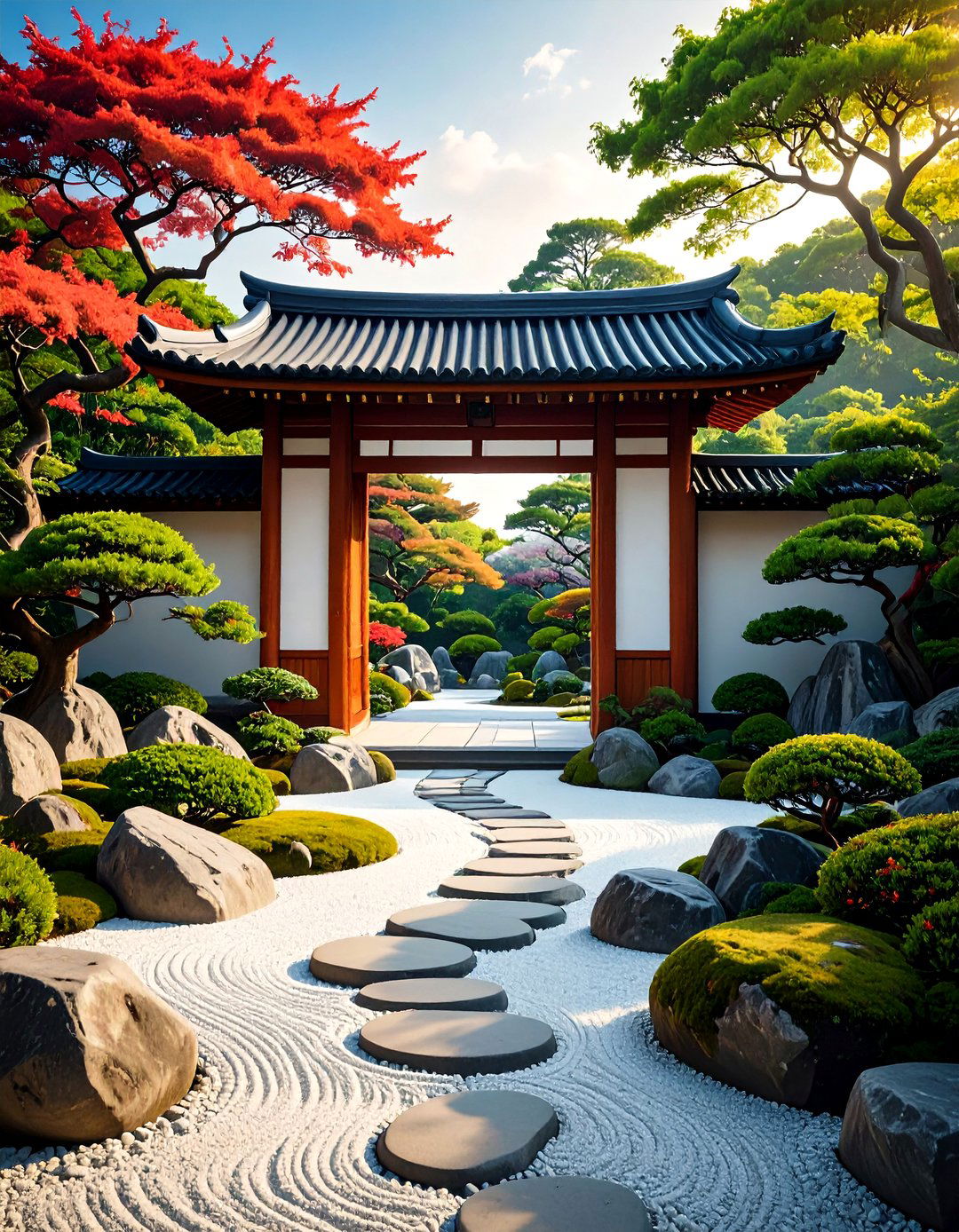
Zen rock garden Japanese garden gate portals offer meditative passageways through carefully arranged rocks, gravel, and subtle landscaping creating serene environments at garden thresholds. Natural, unpretentious materials evoke balance and introspection while clean lines and thoughtful placement reflect traditional Japanese aesthetics. The design philosophy emphasizes emptiness and simplicity, using negative space as actively as physical elements. Carefully raked gravel patterns surrounding the portal entrance create contemplative environments that slow visitors' pace and encourage mindful observation. Stone bridges near boulders representing waterfalls with smaller gravel flowing underneath demonstrate symbolic water elements in zen rock gardens. The gate opening itself becomes secondary to the broader composition of rocks, sand patterns, and carefully positioned elements that create harmonious whole. This minimalist approach particularly suits contemporary gardens seeking authentic zen experiences without elaborate ornamentation.
10. Water Feature Japanese Garden Gate
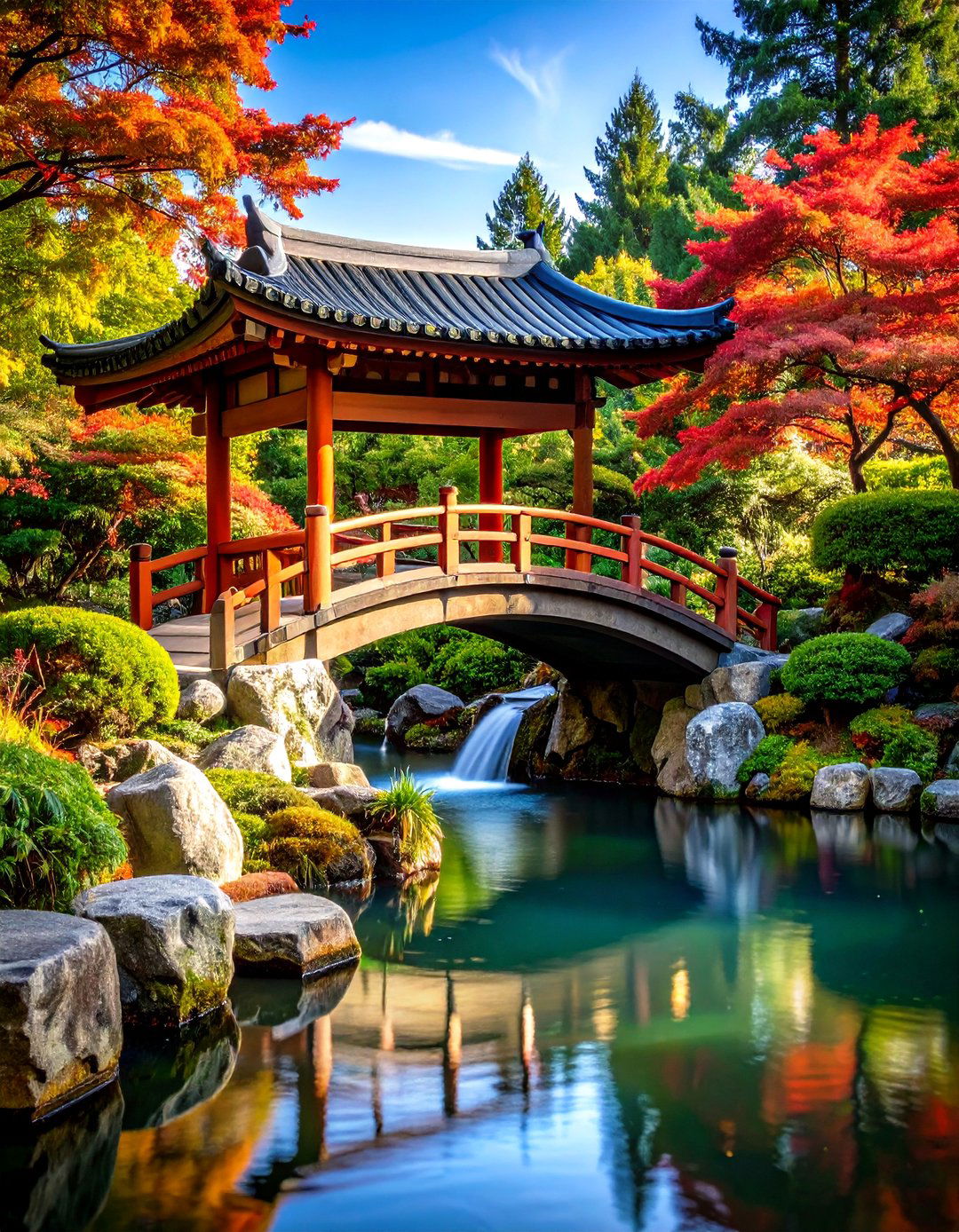
Water feature Japanese garden gates fuse soothing sounds of cascading water with natural stone elements, creating immersive sensory experiences through gentle water flow that enhances tranquility. Soft lighting and textured surfaces add visual drama while combining practical engineering with artistic expression. The integration of water requires careful planning for circulation systems, drainage, and freeze protection in temperate climates. These gates stand as both functional entryways and captivating water features, with refreshing ambiance and timeless style elevating garden's overall appeal. Sound masking benefits help screen urban noise while creating peaceful environments conducive to meditation and contemplation. Construction typically involves stone or concrete basins with recirculating pump systems hidden within gate structures. The water element connects with traditional Japanese garden principles emphasizing natural elements and seasonal change. Maintenance considerations include regular cleaning, pump servicing, and seasonal shutdown procedures to prevent freeze damage.
11. Bamboo and Stone Mosaic Japanese Garden Gate
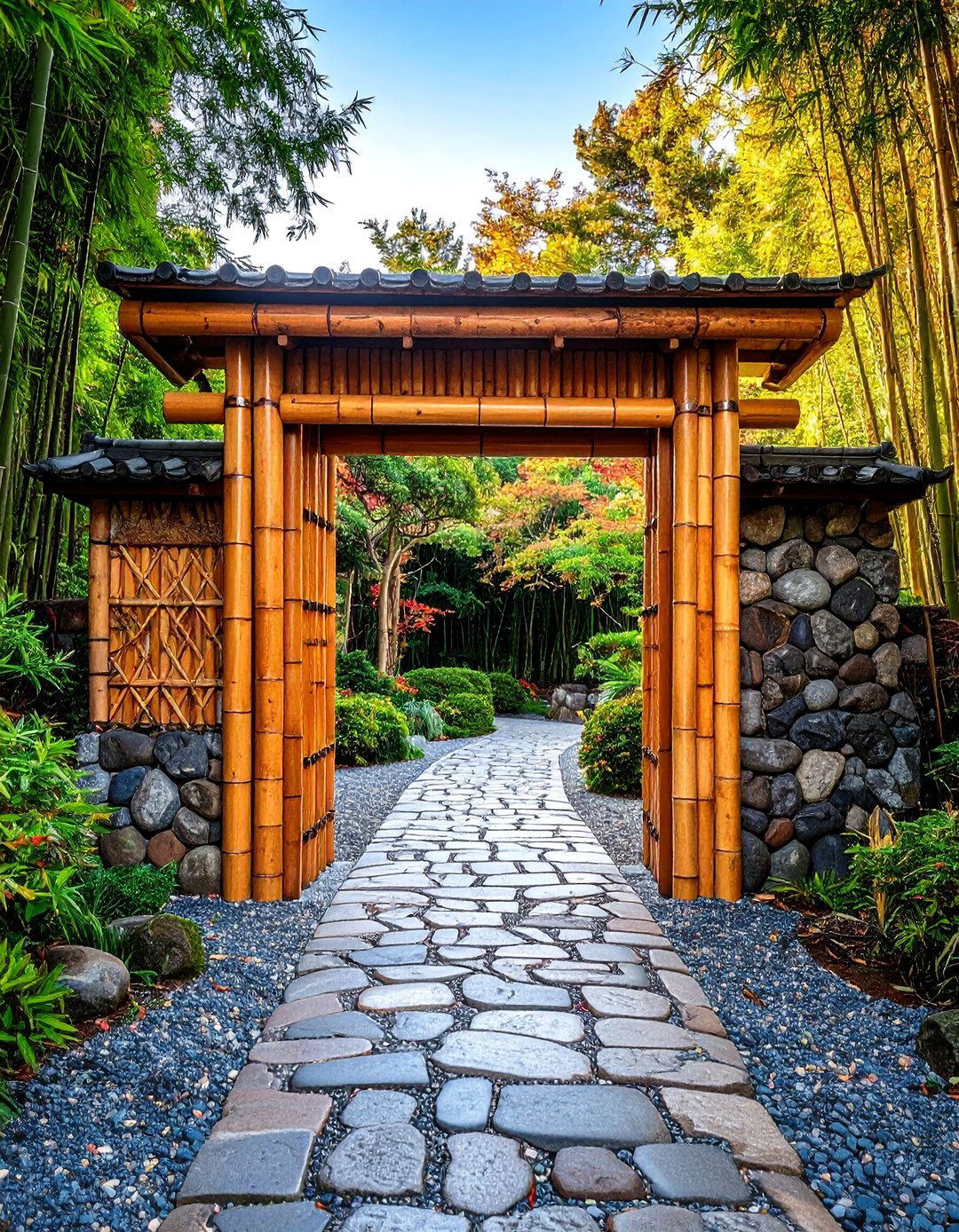
Bamboo and stone mosaic Japanese garden gates showcase seamless blends of organic textures and rugged stone patterns, fusing bamboo warmth with natural stone's enduring strength. Interlocking mosaic patterns and natural hues evoke balance and tranquility while serving as artistic centerpieces inviting visitors to experience unique fusions of cultural heritage and innovative design. The construction process requires skilled artisans capable of working with both materials, creating patterns that celebrate each material's unique properties. Bamboo provides flexibility and organic texture while stone offers permanence and structural integrity. Installation involves careful fitting of bamboo elements into stone framework, often using traditional joinery techniques passed down through generations. The mosaic approach allows creative expression while maintaining authentic Japanese design principles. Weather resistance comes from stone foundation elements protecting bamboo components from ground moisture and providing stable mounting surfaces for organic materials.
12. Traditional Niwamon Japanese Garden Gate with Roof

Traditional Niwamon Japanese garden gates feature prominent roofed structures designed to welcome visitors pleasantly as introductions to garden experiences ahead. These gates often feature gabled roofs (Kirizuma) or hipped gable roofs (irimoya) with cedar shingles, creating substantial architectural presence. The standard dimensions typically measure 396 cm wide, 240 cm deep, and 340 cm high, though all dimensions remain adjustable to suit specific garden requirements. Roof options include original Kawara ceramic tiles, shingles, or planks, with doors made exactly to client specifications. The substantial construction requires proper foundations, typically ring or full concrete foundations depending on soil conditions and local requirements. Construction follows two-phase processes: initial workshop assembly ensuring quality standards, followed by deconstruction, transport, and site reassembly under careful supervision. This traditional approach ensures authentic proportions and joinery techniques while accommodating modern installation requirements.
13. Rope-Wrapped Japanese Garden Gate
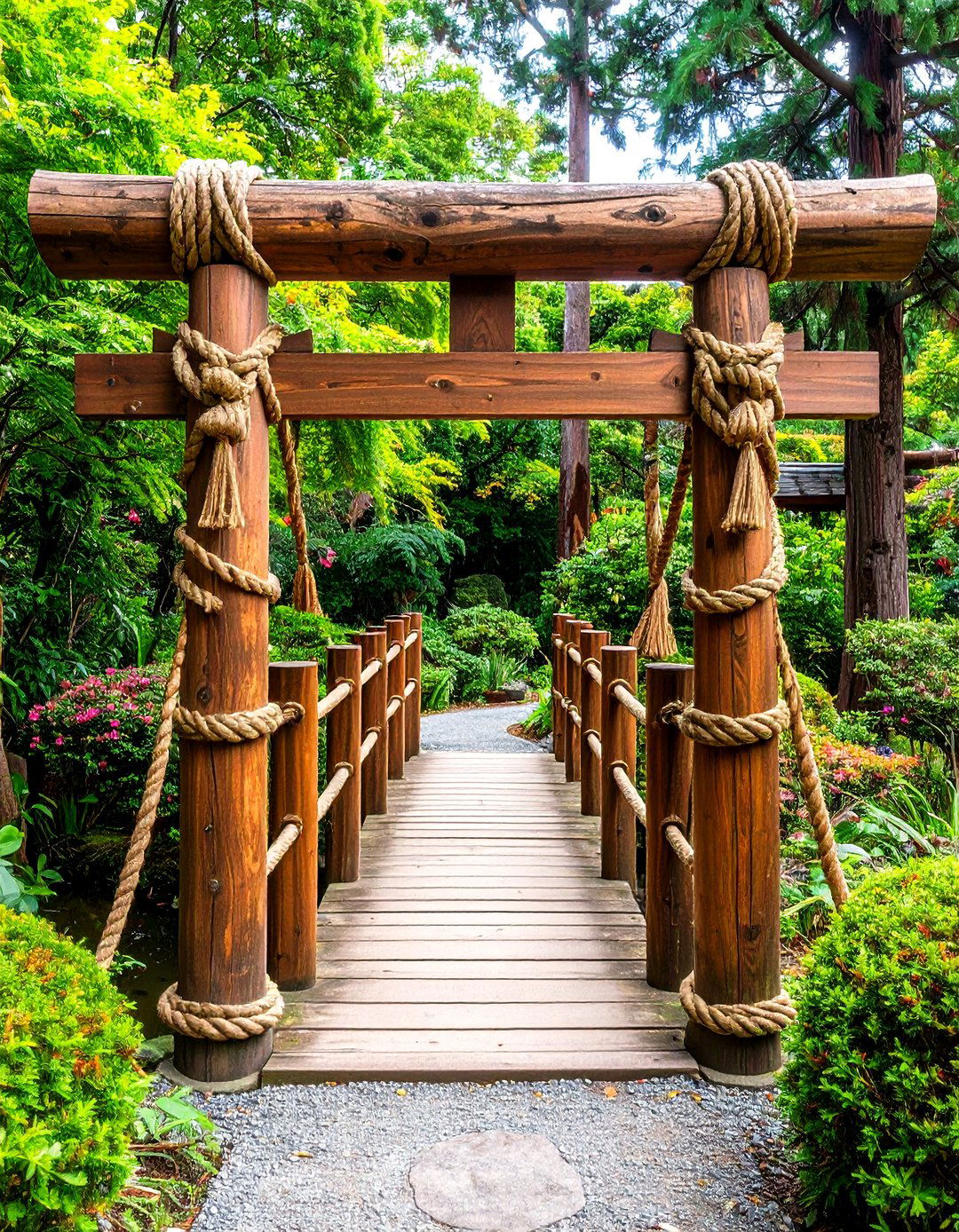
Rope-wrapped Japanese garden gates add unique handcrafted elements through thick ropes wound around wooden or bamboo frames, creating interesting textures and patterns that emphasize natural materials. This design approach celebrates traditional craftsmanship while providing practical benefits including improved grip surfaces and weather protection for underlying structural elements. The emphasis on natural materials and craftsmanship reflects core Japanese aesthetic principles valuing human skill and material authenticity. Traditional rope materials include hemp, cotton, or modern synthetic alternatives offering improved weather resistance and longevity. The wrapping process requires careful planning to ensure even coverage and secure termination points that won't unravel under weather stress. Hand-forged hardware including hinges and latches complement the handcrafted aesthetic, similar to traditional iron hardware used in Japanese courtyards over the last 500 years. Maintenance involves periodic rope replacement as natural materials age and weather, making this design choice ongoing commitment to authentic craftsmanship.
14. Ornate Iron Japanese Garden Gate with Traditional Motifs
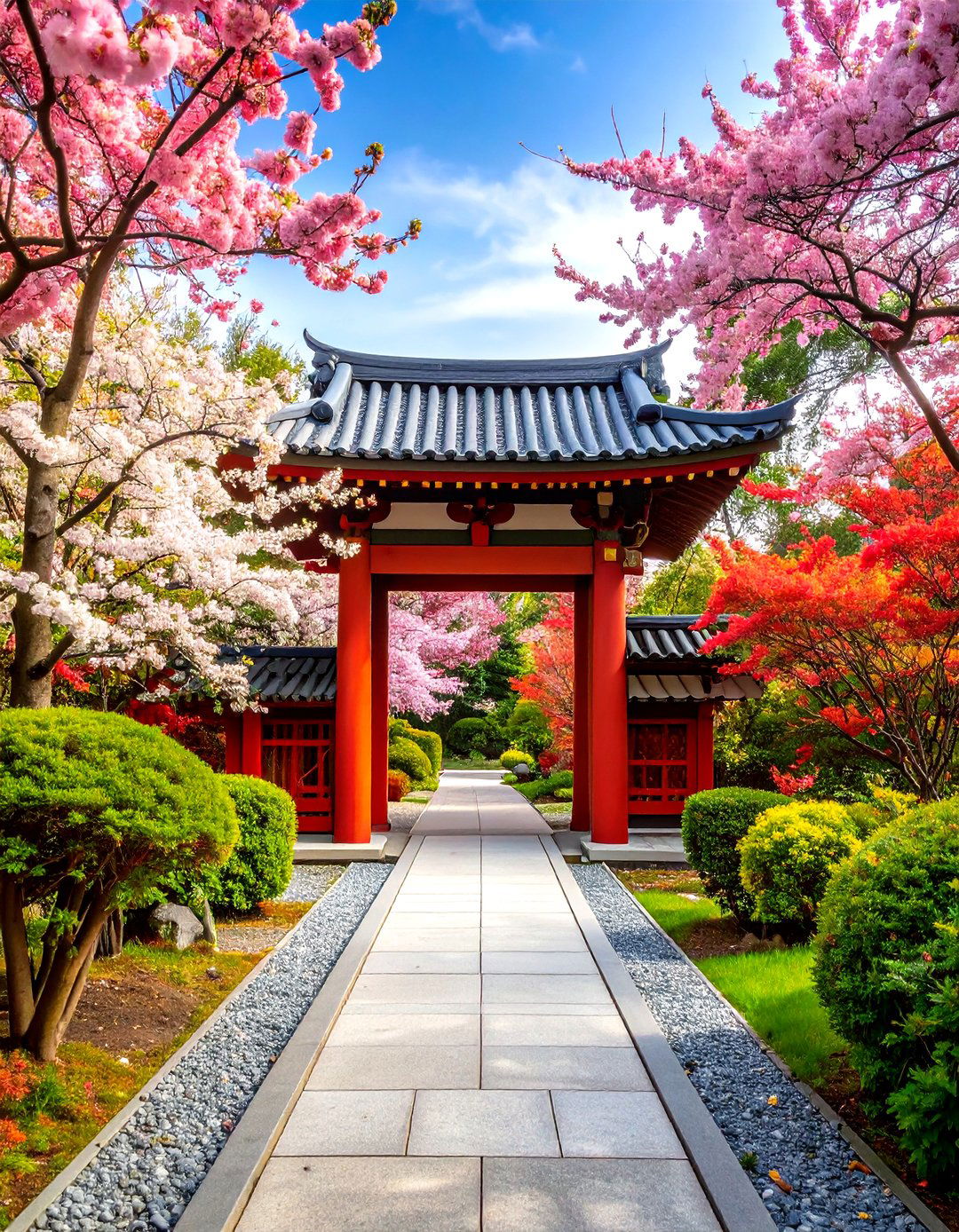
Ornate iron Japanese garden gates combine intricate details with durability, featuring traditional motifs like cherry blossoms or cranes that add cultural significance to modern garden designs. Iron construction requires minimal maintenance while accommodating paint finishes matching garden color schemes, offering blends of tradition and practical durability. The metalworking process allows incorporation of complex designs impossible with wooden construction, including delicate flowering branch patterns and stylized wildlife elements central to Japanese artistic traditions. Master craftsmen create custom designs incorporating ginkgo leaves and other natural patterns that connect with broader garden themes. Powder coating provides superior weather resistance compared to traditional paint finishes, ensuring decades of service with minimal maintenance requirements. The substantial weight requires heavy-duty hinges and proper gate post construction to prevent sagging over time. This approach particularly suits gardens requiring security while maintaining aesthetic appeal and cultural authenticity through meaningful symbolic elements.
15. Sliding Panel Japanese Garden Gate System
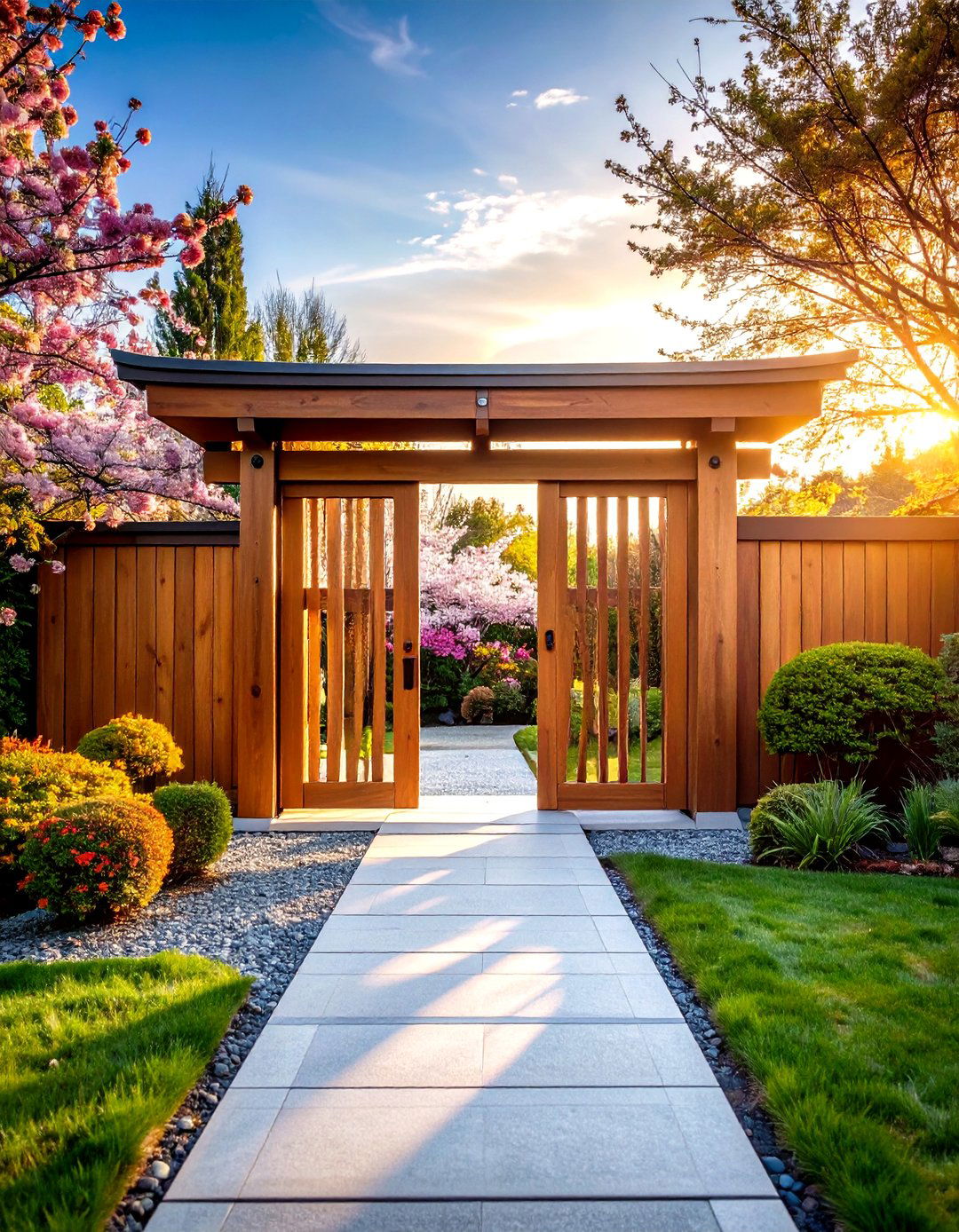
Sliding panel Japanese garden gates utilize modern sliding mechanisms paired with wooden slats in varied widths, casting striped shadows across ground at different times throughout the day. This design feels both functional and poetic, inspired by mountain homes in Yunnan where slatted shade screens are used extensively. The space-saving design suits tight mountain lots and urban gardens where traditional swing gates prove impractical due to space constraints. Mounting systems allow gates to disappear behind walls or hedges when opened, creating lighter, more integrated appearances. Material choices include dark wood for light exteriors or pale oak and cedar for charcoal or stone siding applications. The slatted design provides privacy while maintaining air circulation and visual connection with garden spaces beyond. Track systems require proper drainage and regular maintenance to ensure smooth operation through seasonal weather changes. Modern ball-bearing track systems offer superior longevity compared to traditional sliding mechanisms.
16. Minimalist Contemporary Japanese Garden Gate
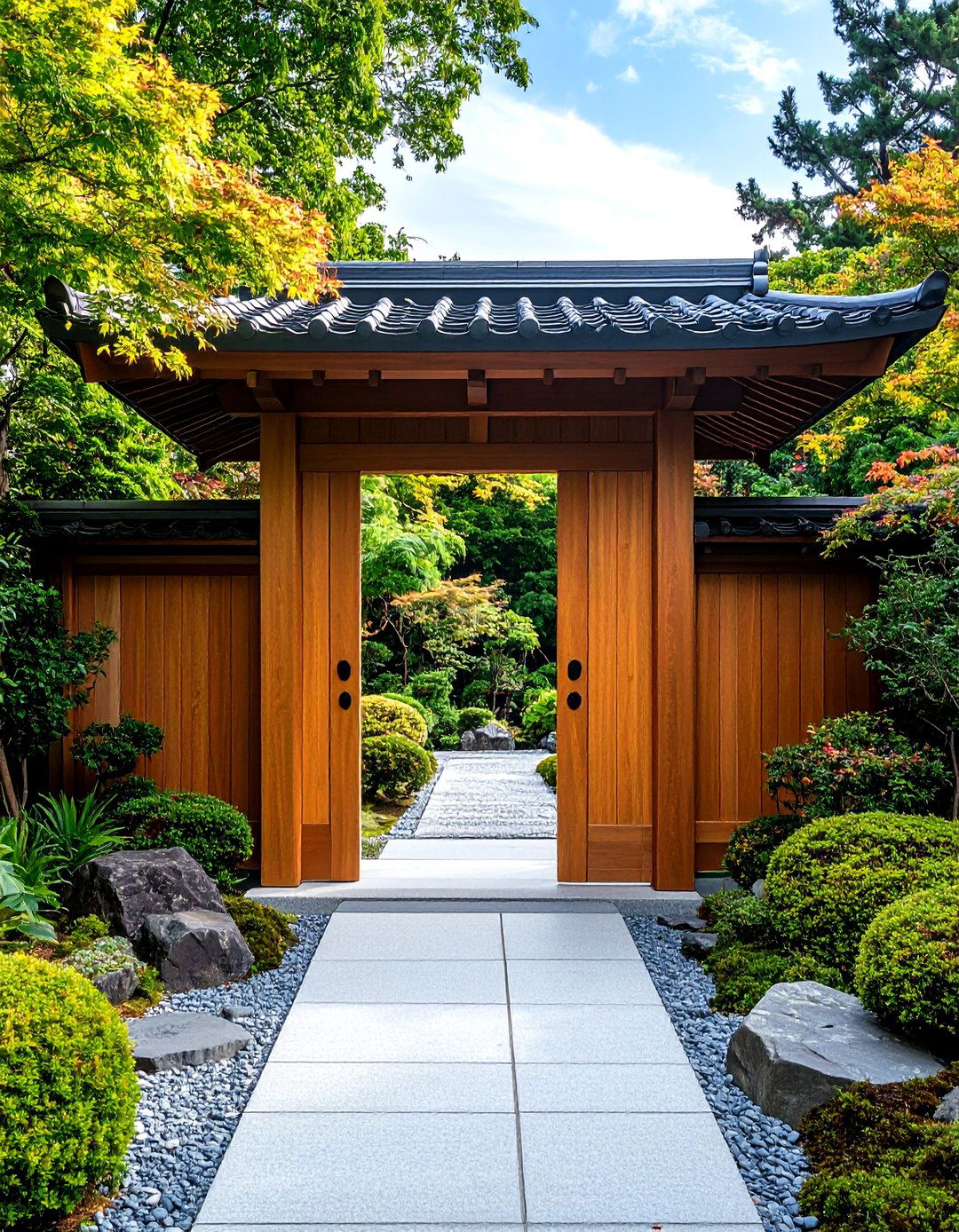
Contemporary interpretations of Japanese garden gates emphasize clean lines, geometric precision, and material honesty while respecting traditional proportional relationships and spatial concepts. Modern designs incorporate minimalist aesthetics with natural materials, creating harmonious and calming atmospheres through intentional simplicity. Steel framework supports wooden infill panels, creating contrast between industrial and organic materials that reflects contemporary design sensibilities. Zen-inspired designs focus on tranquility and serenity through clean lines, natural materials, and minimalist approaches that create peaceful sanctuaries. The reduction of ornamental elements allows material qualities and proportional relationships to communicate aesthetic intentions without decorative distractions. Installation techniques utilize modern hardware and joining methods while maintaining visual connection to traditional design principles. This approach particularly appeals to urban gardens where contemporary architecture requires gates reflecting current design sensibilities while honoring Japanese garden philosophy through spatial organization and material selection.
17. Split-Rail Saloon Japanese Garden Gate
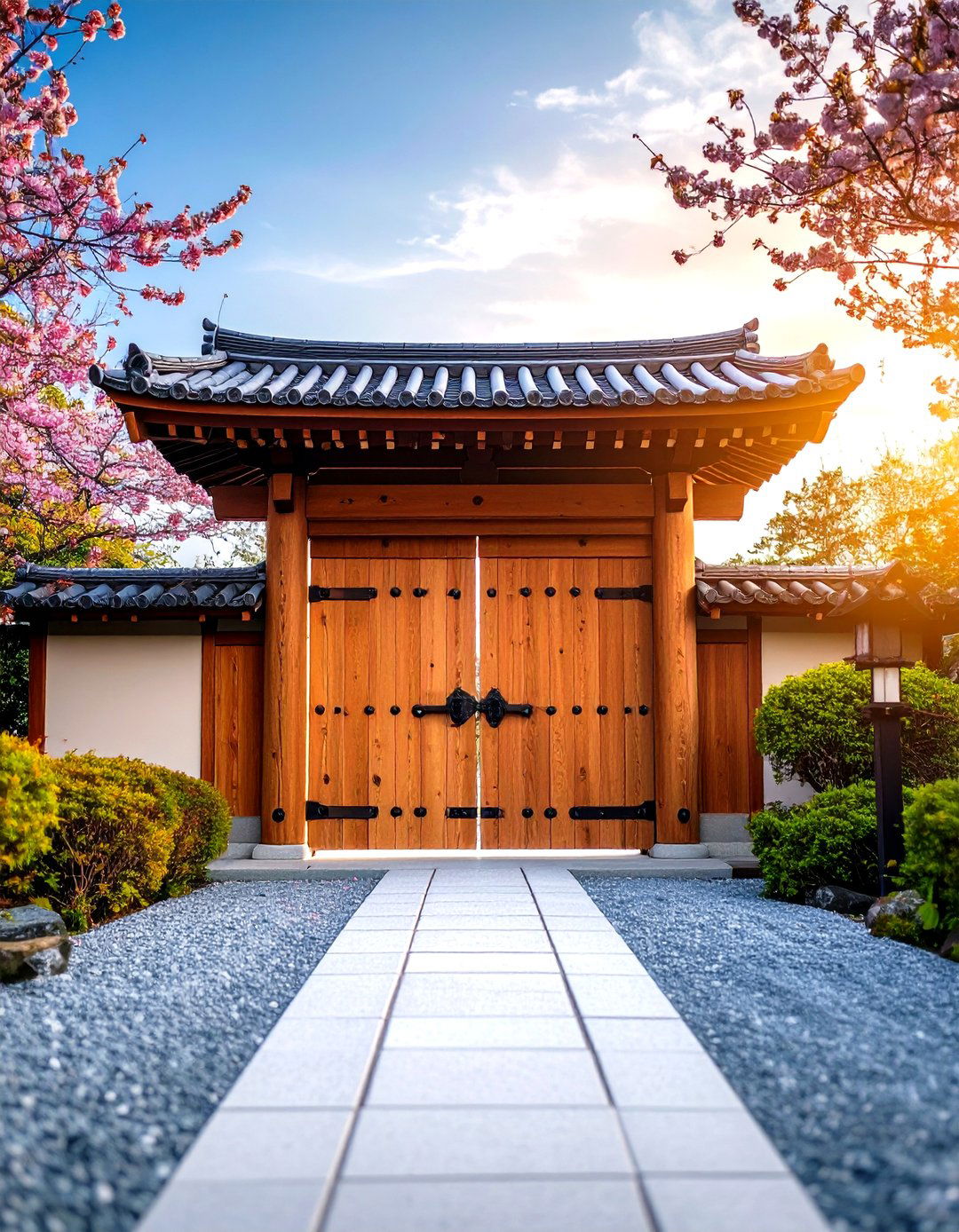
Split-rail saloon style Japanese garden gates feature double swinging panels opening from center, with both gates swinging open for wheelbarrow access while single gate serves daily pedestrian traffic. Cane bolt systems on left gates slide down into drilled stone holes set into ground, securing one side while maintaining operational flexibility. This practical design balances security with convenience, allowing variable opening widths depending on garden maintenance requirements and visitor access needs. Hand-forged hinges and cane bolts complement woodwork craftsmanship, echoing traditional iron hardware used in Japanese courtyards over centuries. The split design reduces individual panel weight, minimizing stress on hinges and gate posts while providing operational redundancy if one panel requires maintenance. Construction typically involves mortise and tenon joinery for maximum strength and traditional appearance. The saloon style creates welcoming atmosphere while maintaining boundary definition between garden spaces and exterior areas, particularly effective in formal garden entries requiring ceremonial presence.
18. Ginkgo Leaf Carved Japanese Garden Gate
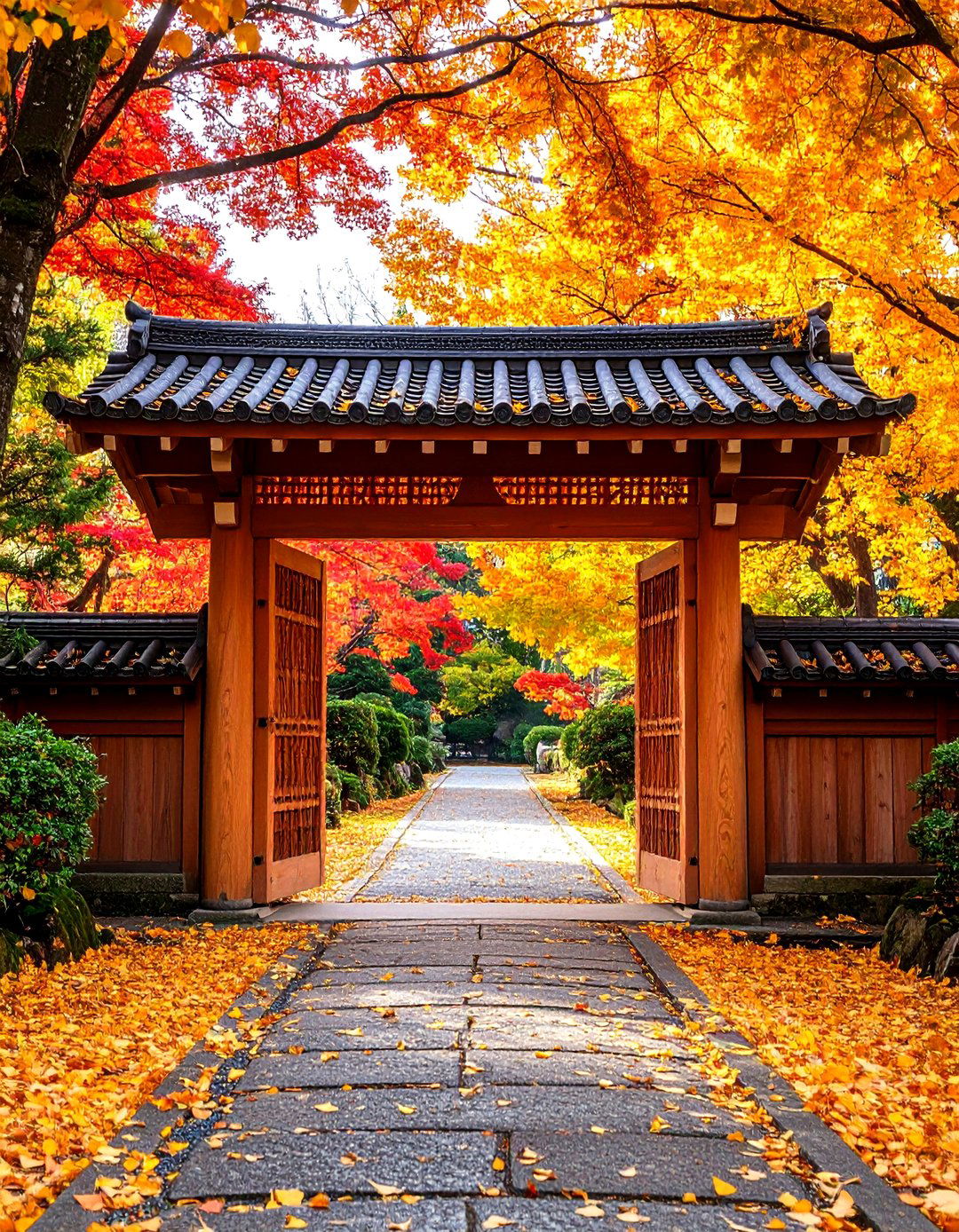
Ginkgo leaf carved Japanese garden gates feature falling ginkgo leaves pierced through lower panels combined with traditional Japanese gridwork at the top, creating custom artistic expressions. The thin lower boards are lightweight and easy to pierce with ginkgo leaf shapes, while preventing gaps between boards through brad attachment that allows wood movement without splitting. This design celebrates seasonal change through symbolic representation of autumn leaf fall, connecting garden experiences with natural cycles central to Japanese garden philosophy. Master craftsmen utilize slip-tenon joinery approaches making traditional joints simpler while maintaining structural integrity through 2-inch-deep mortises in frame pieces. The carving process requires skilled woodworkers capable of creating detailed organic shapes without compromising structural elements. Ginkgo symbolism represents longevity, peace, and environmental harmony—concepts particularly meaningful in Japanese cultural contexts. The combination of carved elements with traditional gridwork demonstrates sophisticated design integration celebrating both artistic expression and structural functionality within unified aesthetic frameworks.
19. Bamboo Diamond Pattern Japanese Garden Gate
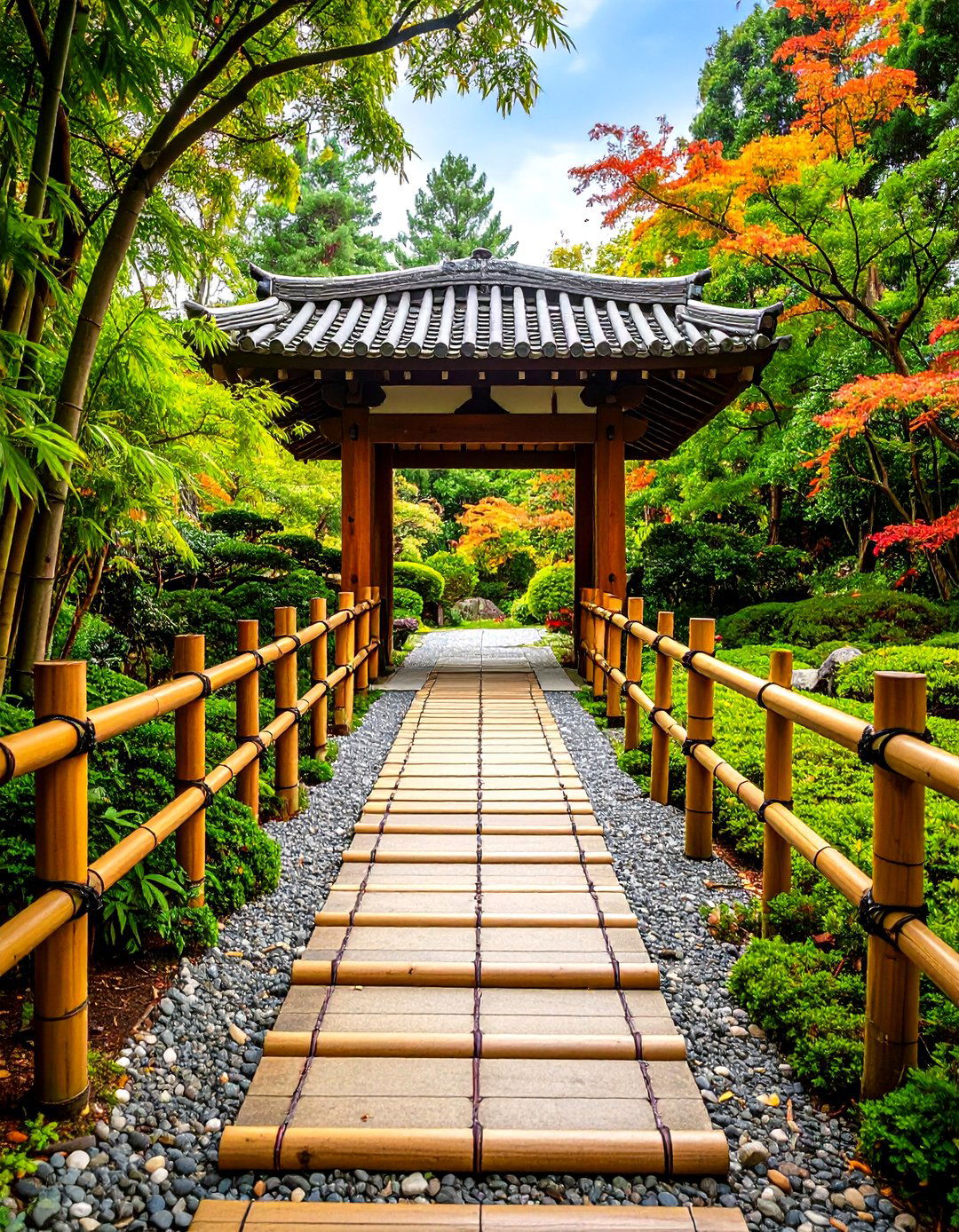
Bamboo diamond pattern Japanese garden gates feature horizontal cross rails with split bamboo set in diamond patterns secured with black string knots, creating attractive traditional screens. These handmade natural bamboo pole constructions include diagonal slats tied with traditional willow knots, though bamboo remains liable to splitting and discoloration over time. The geometric diamond pattern provides visual interest while maintaining structural integrity through triangulated design principles that distribute stress loads effectively across the framework. Handmade construction from natural products creates slight variations in color and finish, adding authentic character impossible to achieve through machine manufacturing. Traditional string tying techniques require periodic maintenance as natural materials age and stretch under weather exposure. The pattern creates interesting shadow play throughout daily sun movement, adding temporal dimension to garden experiences. Installation requires careful attention to panel alignment and secure mounting to prevent wind damage during severe weather conditions.
20. Multi-Material Fusion Japanese Garden Gate
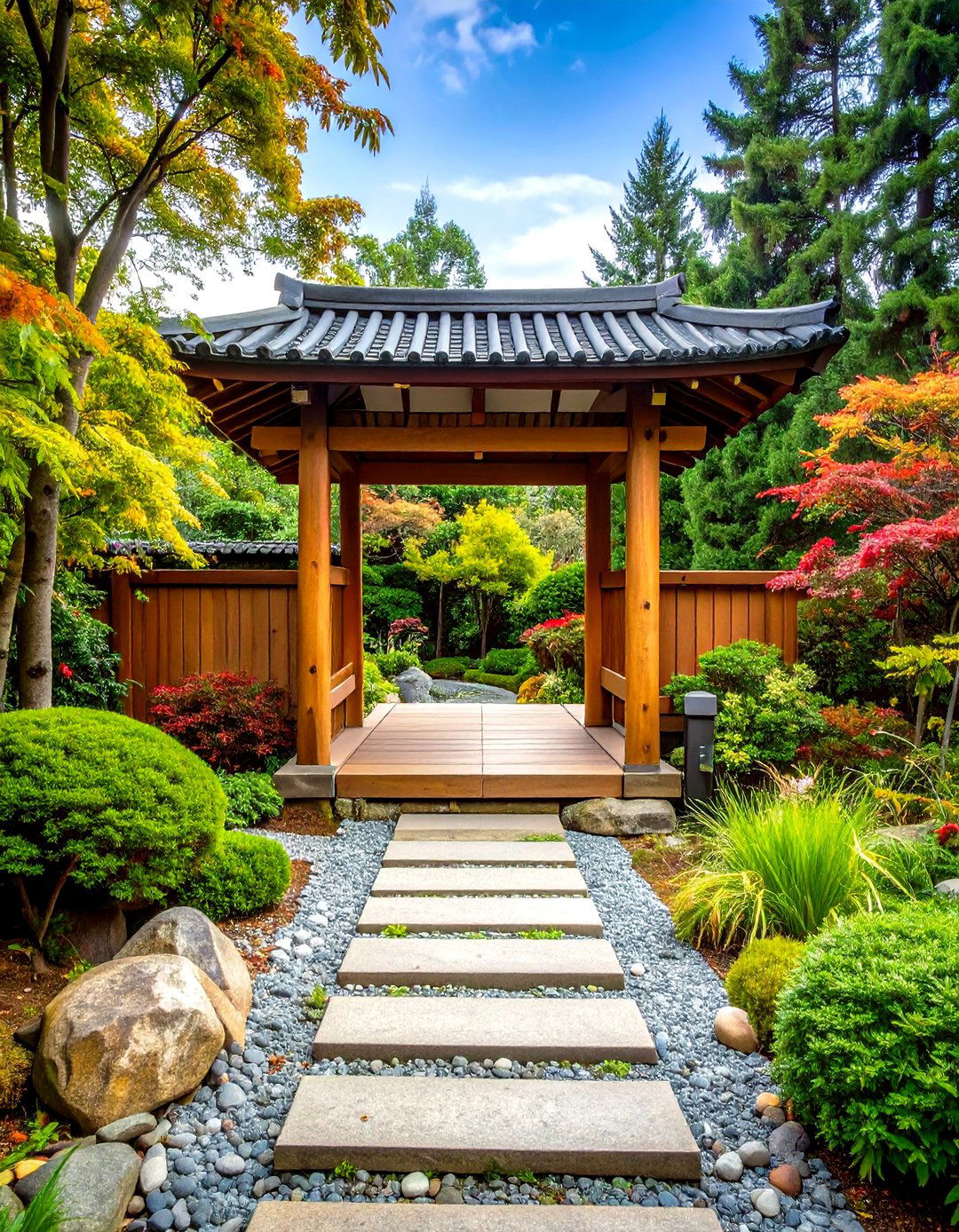
Multi-material fusion Japanese garden gates combine various authentic elements including cedar framework, bamboo infill sections, stone accent posts, and traditional hardware into cohesive unified designs. This approach allows creative expression while honoring individual material properties and traditional construction techniques passed down through generations. The design incorporates materials and colors from home architecture while introducing materials fitting Japanese garden ideals, creating intimate spaces between fence and house. Bamboo poles provide Asian charm in fence fields while bamboo ceiling treatments surprise guests entering through gates with elegant craftsman detailing. Construction complexity requires skilled artisans understanding multiple material properties and appropriate joining techniques for dissimilar materials. Weather protection strategies must account for different expansion rates and moisture sensitivity across material types. The fusion approach particularly suits gardens bridging Eastern and Western design sensibilities, creating unique expressions honoring multiple cultural influences while maintaining authentic Japanese aesthetic principles through careful proportion and spatial organization.
Conclusion:
Japanese garden gates transcend mere functional barriers, embodying philosophical principles of harmony, transition, and spiritual contemplation. Whether featuring traditional vermillion torii designs, weathered cedar construction, or contemporary bamboo innovations, each gate creates awareness of passing from mundane to sacred spaces. The careful selection of materials, proportions, and symbolic elements transforms simple passageways into artistic centerpieces that enhance garden experiences while honoring centuries of cultural wisdom. From minimalist zen portals to elaborate roofed Niwamon structures, these twenty design ideas offer pathways to creating authentic Japanese garden entrances that invite contemplation, celebrate natural beauty, and provide lasting architectural heritage for generations to enjoy.


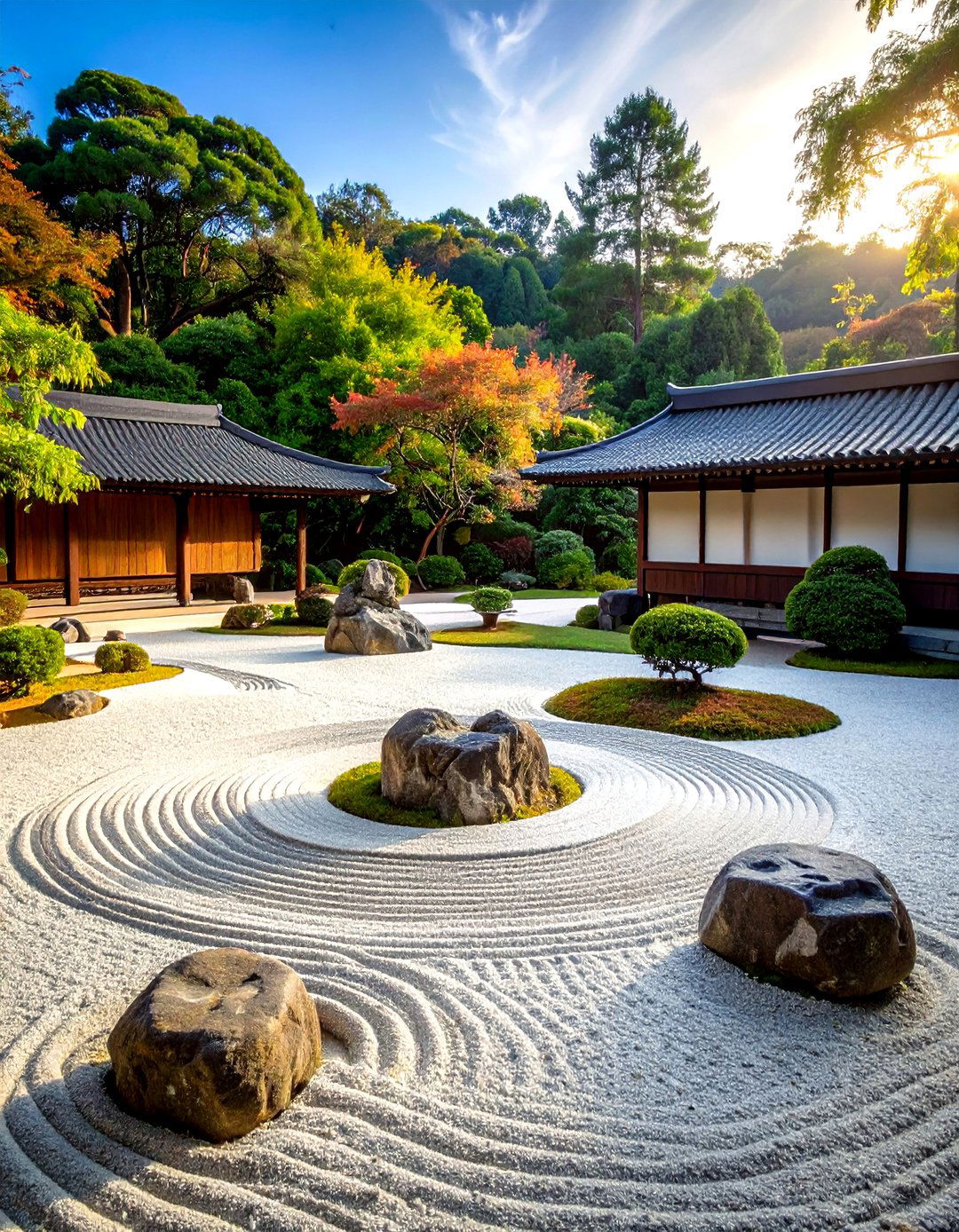



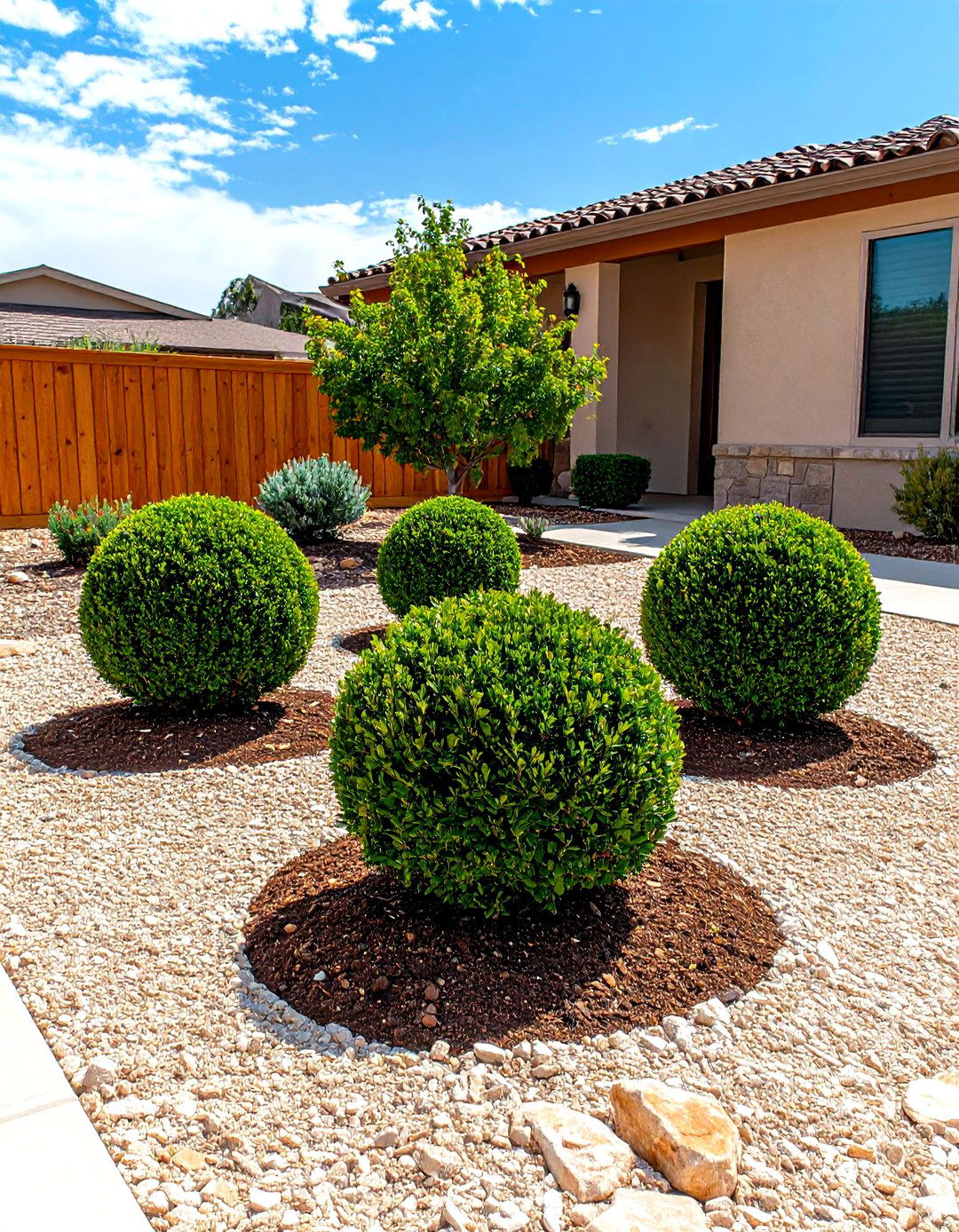







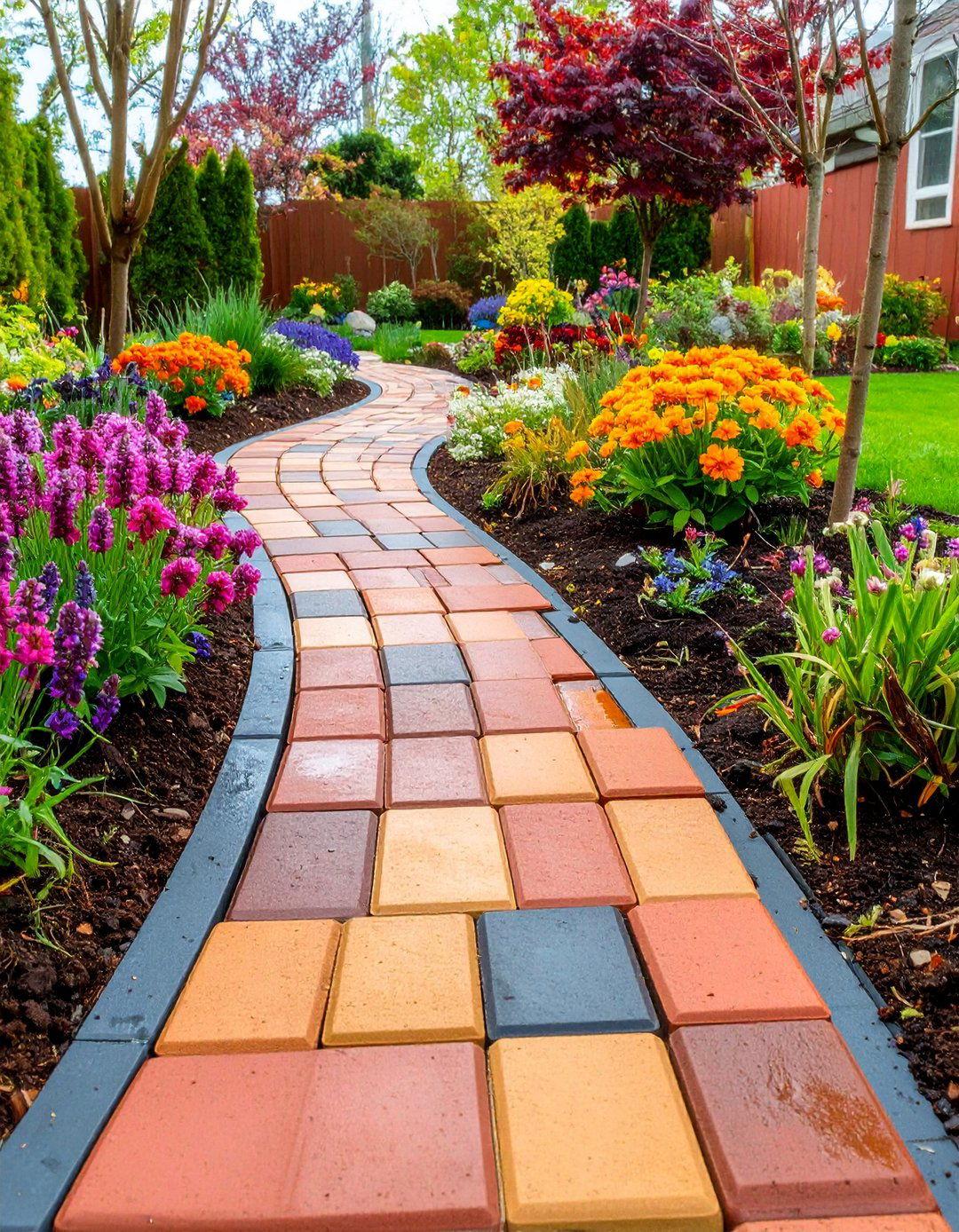
Leave a Reply